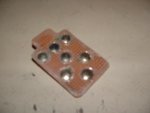I have just found I cannot get switches in a remote control box, and wondered if touch switches can be made easily. I thought at first I could just have 4 raised bolt heads, but then reading posts found you must not touch them? I seem to remember a similar to bolthead, a split where your finger bridged accross.
I am wanting something presentable to replace switches, any ideas, thanks
I am wanting something presentable to replace switches, any ideas, thanks

